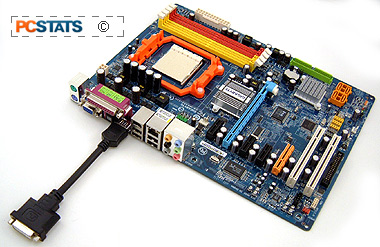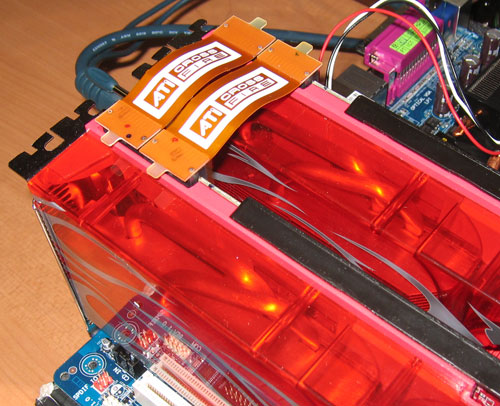 The point of
something like HDCP is to (rightly or wrongly) ensure that only legitimate High Definition content is
played, if the HDCP keys don't match or are missing content plays at a reduced
quality. This standard was spearheaded by the movie industry in an attempt to
combat piracy, and well... we're stuck with it. To learn more about HDCP,
read this PCSTATS article.
The point of
something like HDCP is to (rightly or wrongly) ensure that only legitimate High Definition content is
played, if the HDCP keys don't match or are missing content plays at a reduced
quality. This standard was spearheaded by the movie industry in an attempt to
combat piracy, and well... we're stuck with it. To learn more about HDCP,
read this PCSTATS article.
So to recap, the AMD 690G and its integrated ATi Radeon
X1250 'RD580' graphics card support HDCP and are Windows Vista
compatible. It has two onboard video output options, analog and digital DVI, but the DVI shares
the same jack as the HDMI and both cannot be used at the
same time.
The motherboard doesn't have a single chipset cooling fan, so if you build
carefully you can create a computer which is nearly silent. This is why the AMD
690G is the darling of the Home Theatre PC world right now.
Configuring AMD Crossfire on the
AMD 690G
One of the coolest features of the Gigabyte GA-MA69G-S3H motherboard is that it supports AMD's CrossFire technology. Yes you read that right, the budget platform can run two AMD videocards of the same GPU and memory size together for more 3D rendering power.
CrossFire is set up a bit differently on the Gigabyte GA-MA69G-S3H motherboard than with the CrossFire Xpress 3200 and 1600 chipsets. With the AMD 690G and specifically the Gigabyte GA-MA69G-S3H motherboard, the first videocard has 16 PCI Express lanes while the second videocard only gets four. This means the secondary videocard cannot get as much data to and from the system as the main videocard and thus, this method of CrossFire is slightly slower than the other method. Unless you're playing games at super high resolutions and with AA/AF maxed out though, you probably wouldn't notice the performance difference to what Gigabyte has done and with a CrossFire Xpress 3200 motherboard.

To physically set CrossFire up on the Gigabyte GA-MA69G-S3H motherboard, you simply insert the first card into the blue primary PCI Express x16 slot and the second videocard into the orange PCI Express x4 slot. If you're using the newer AMD cards which support internal CrossFire bridges simply connect things up (as shown above with Radeon HD 2900XT videocards). If you're using an older CrossFire setup, connecting the external cables as you would normally.
Once that's done, enable AMD CrossFire through the
Catalyst drivers and you're set. Just remember though AMD's gaming class
videocards may have quite a large power requirements so if you plan on gaming or
using CrossFire technology, you'll want to equip your machine with a beefy power
supply. Generally a name brand model like Seasonic or PC Power & Cooling
should be sufficient but if you're at a loss at what to get, AMD has a CrossFire
approved list here. Any one of those power supplies will do.
First let's look at a closer look at the motherboard and then take a look at
what makes AMD's 690G chipset so interesting.
